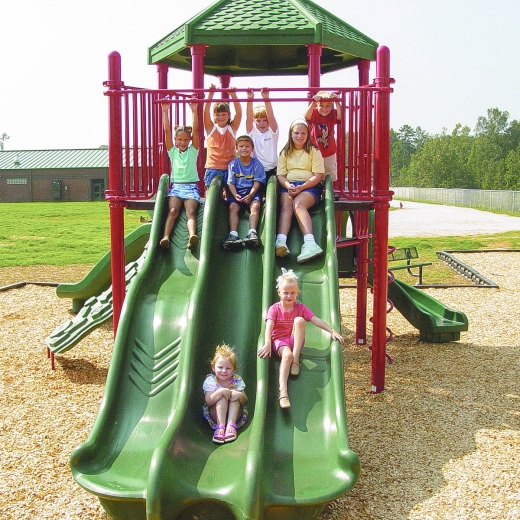A slide is a great interactive component for children of all ages but there is some code to keep in mind to ensure that your slides are safe and compliant. Luckily, most straight, tube and spiral slides follow the same regulations.
To begin with, all slides must have a way to channel the child into a sitting position before they use the equipment. This can be a hood, panel, bar, tube or any other chute entry device that encourages the child to sit down and slide rather than run down the slide dangerously. At the end of the slide, the exit height (the distance from the slide exit to the safety surfacing) must be between 0”-11″ for slides with an elevation less than 48″ and between 7″-15″ for slides with an elevation greater than 48”. This allows the user to comfortably stop their slide and come to a standing position.
The safety surfacing at the base of slides is often an issue as it can become worn down or damaged with prolonged use. Instead of redoing the entire safety surface, there are two popular solutions. The first involves repairing or replenishing the safety surface. If you have poured in place rubber, Trassig offers a do-it-yourself poured in place patch kit that repairs worn, damaged areas in a few simple steps. If you have a non-unitary surface, such as wood fibers or rubber mulch, the best solution is to simply replenish that area. Purchasing a wear mat is the second solution. This thick mat fills the gap between the slide exit and the surfacing to make sure the exit height is up to code. These are also useful underneath swings!
The bedway must also meet certain standards. For example, the walls must be no less than 4″ high to contain the user and prevent him from falling out. The width of the slide must be at least 12” for pre-school aged children and at least 16” for school aged children. Tube slides must have a minimum interior diameter of 23”. Regardless of the age group, the average slope must not be greater than 30 degrees, with a maximum slope of 50 degrees.
When you are inspecting your slide it is important to pay attention to both the non-entanglement zone and the clearance zone. The non-entanglement zone extends over the length of the slide and means that there is no projection such as a screw or gap between the slide and platform that could catch a loose article of clothing and present an entanglement hazard. You should also make sure there is an adequate clearance zone around the slide and at its exit so that there are no adjacent pieces of equipment or components that could present a hazard to the child while they are on or once they have exited the slide.
Call Trassig at 203-659-0456 or email info@trassig.com if you have any questions about slide safety.
About us
Contact Trassig before you build your playground. We can help with Risk Management Consulting and ASTM Compliance, review your plans and ensure that your playground is built to NPCAI standards, and also review the accessibility of your design and help you become ADA compliant. With our knowledge and expertise your playground will challenge your target audience and pass inspection.

